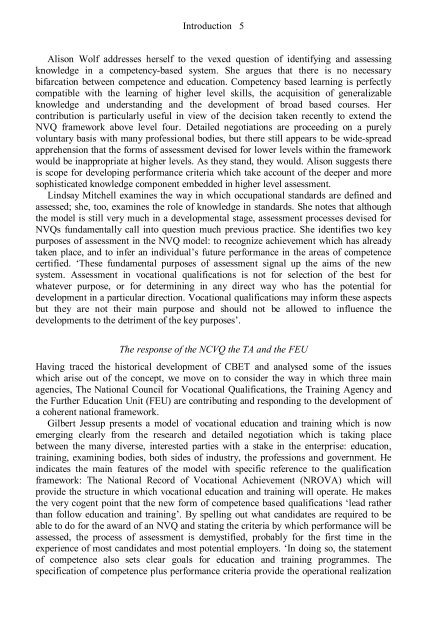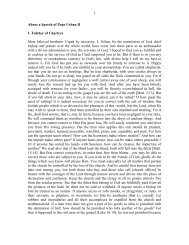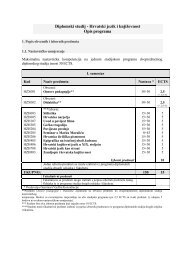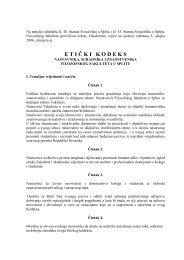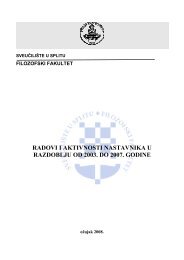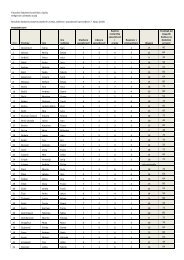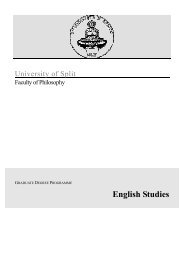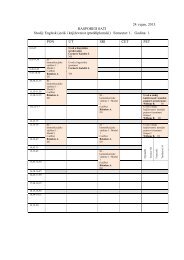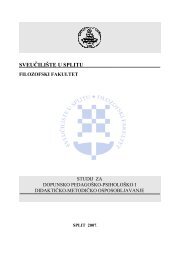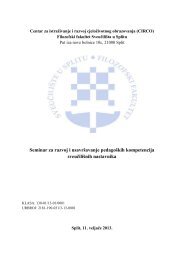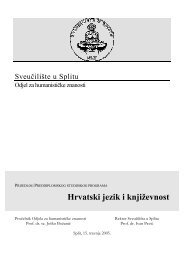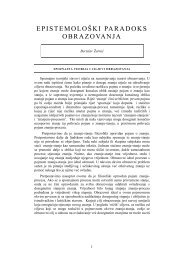Competency Based Education and Training
Competency Based Education and Training
Competency Based Education and Training
You also want an ePaper? Increase the reach of your titles
YUMPU automatically turns print PDFs into web optimized ePapers that Google loves.
Introduction 5<br />
Alison Wolf addresses herself to the vexed question of identifying <strong>and</strong> assessing<br />
knowledge in a competency-based system. She argues that there is no necessary<br />
bifarcation between competence <strong>and</strong> education. <strong>Competency</strong> based learning is perfectly<br />
compatible with the learning of higher level skills, the acquisition of generalizable<br />
knowledge <strong>and</strong> underst<strong>and</strong>ing <strong>and</strong> the development of broad based courses. Her<br />
contribution is particularly useful in view of the decision taken recently to extend the<br />
NVQ framework above level four. Detailed negotiations are proceeding on a purely<br />
voluntary basis with many professional bodies, but there still appears to be wide-spread<br />
apprehension that the forms of assessment devised for lower levels within the framework<br />
would be inappropriate at higher levels. As they st<strong>and</strong>, they would. Alison suggests there<br />
is scope for developing performance criteria which take account of the deeper <strong>and</strong> more<br />
sophisticated knowledge component embedded in higher level assessment.<br />
Lindsay Mitchell examines the way in which occupational st<strong>and</strong>ards are defined <strong>and</strong><br />
assessed; she, too, examines the role of knowledge in st<strong>and</strong>ards. She notes that although<br />
the model is still very much in a developmental stage, assessment processes devised for<br />
NVQs fundamentally call into question much previous practice. She identifies two key<br />
purposes of assessment in the NVQ model: to recognize achievement which has already<br />
taken place, <strong>and</strong> to infer an individual’s future performance in the areas of competence<br />
certified. ‘These fundamental purposes of assessment signal up the aims of the new<br />
system. Assessment in vocational qualifications is not for selection of the best for<br />
whatever purpose, or for determining in any direct way who has the potential for<br />
development in a particular direction. Vocational qualifications may inform these aspects<br />
but they are not their main purpose <strong>and</strong> should not be allowed to influence the<br />
developments to the detriment of the key purposes’.<br />
The response of the NCVQ the TA <strong>and</strong> the FEU<br />
Having traced the historical development of CBET <strong>and</strong> analysed some of the issues<br />
which arise out of the concept, we move on to consider the way in which three main<br />
agencies, The National Council for Vocational Qualifications, the <strong>Training</strong> Agency <strong>and</strong><br />
the Further <strong>Education</strong> Unit (FEU) are contributing <strong>and</strong> responding to the development of<br />
a coherent national framework.<br />
Gilbert Jessup presents a model of vocational education <strong>and</strong> training which is now<br />
emerging clearly from the research <strong>and</strong> detailed negotiation which is taking place<br />
between the many diverse, interested parties with a stake in the enterprise: education,<br />
training, examining bodies, both sides of industry, the professions <strong>and</strong> government. He<br />
indicates the main features of the model with specific reference to the qualification<br />
framework: The National Record of Vocational Achievement (NROVA) which will<br />
provide the structure in which vocational education <strong>and</strong> training will operate. He makes<br />
the very cogent point that the new form of competence based qualifications ‘lead rather<br />
than follow education <strong>and</strong> training’. By spelling out what c<strong>and</strong>idates are required to be<br />
able to do for the award of an NVQ <strong>and</strong> stating the criteria by which performance will be<br />
assessed, the process of assessment is demystified, probably for the first time in the<br />
experience of most c<strong>and</strong>idates <strong>and</strong> most potential employers. ‘In doing so, the statement<br />
of competence also sets clear goals for education <strong>and</strong> training programmes. The<br />
specification of competence plus performance criteria provide the operational realization


